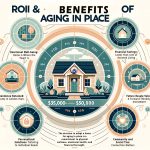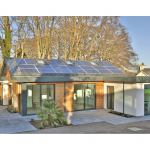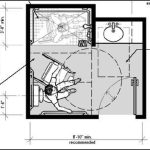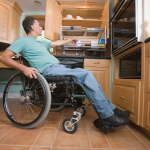So you’re a senior and you and your spouse know you want to live independent lives for as long as possible. You also probably realize that’s going to take some changes to your current home.
Sometimes the most difficult decision for renovating pertains to how the homeowner will pay for the updates. If this is the case for you, then you’ve come to the right place.
This page provides basic information regarding programs and opportunities for homeowners that offer financial assistance for home repairs and home improvements related to accommodating medical issues or special needs and aging in place designs.
What’s more, according to the federal Fair Housing Act, you don’t need to be a homeowner to take advantage of many of these opportunities.
Learn more about what your current benefits will cover and what other programs are available. But first, a quick note on the Fair Housing Act (also known as the “disabilities act”) to get started. If you still have questions when you’re finished reading this article, don’t hesitate to reach out!
The Fair Housing Act Ensures Seniors Can Make Home Modifications to Live Independently Longer
AARP actually published a great overview of the Fair Housing Act (or FHA) and how it works for seniors. The FHA is a federal law prohibiting housing providers like property owners and managers, landlords, and other associations or real estate professionals to discriminate based on several things…including disability.
In conjunction with fair treatment of those with disabilities, this disabilities act also requires landlords “to make reasonable accommodations and allow reasonable modifications. So that people with disabilities can use and enjoy housing on an equal basis.”
The central idea is to help ensure older adults can live independent lives for as long as possible. For more details on the disabilities act and what it entails, click here and read through the presentation.
Ultimately, whether you are a rental resident who is discussing appropriate updates with your landlord, living with a family or household member, or still fully independent and aging in place, you have a right to accessibility.
Now, let’s talk coverage…
What Current Medicare or Medicaid Benefits Will (and Won’t) Cover for Home Modifications
You may not be aware of this, but if you are eligible for or already participate in some governmental health coverage programs, you may also be able to have your medical or aging-in-place home modifications covered as well.
Eligibility can be complicated, though, so it is important to understand what is and isn’t covered, and by which programs.
Original Medicare Program Does Not Cover Most Home Modifications
While the original Medicare program does not offer coverage for many home modifications, they do pay for some related items and services. Examples include:
- Dwelling evaluation and recommendations for the proper changes
- Doctor-prescribed assistive technology devices
- Medically necessary home components like grab bars, walk-in tubs, stair lifts
To be clear, evaluations must be performed by in-network healthcare providers. An occupational therapist, for instance, can advise what updates would be necessary for you to live in place.
Additionally, only the actual materials and hardware are covered for assistive technology devices – not the construction or contractor costs.
Your Medicare Advantage Plan Could Bridge That Gap
Beginning in 2019, the Centers for Medicare and Medicaid Services (CMS) actually expanded coverage to include home renovations for enrollees who demonstrated a medical need for them.
If you are a current recipient of Original Medicare, during your next enrollment period, you may want to evaluate whether it makes sense for you to consider a shift over to one of the hundreds of private insurer-managed Medicare Advantage plans available.
In the next year, we’ll see a further expansion to include non-medical benefits for chronically ill patients. This means your home modifications may be covered when “a reasonable expectation of improving or maintaining [your] health or overall function” is provided.
Ramps — one of the most common necessary home renovations — are a perfect example for demonstrating the difference in coverage for this expense.
Ramps and the Durable Medical Equipment Policy
Two of the most common updates included in aging-in-place renovation plans are adding ramps and a more convenient bathtub or soaking tubs. Under Original Medicare guidelines, ramps are considered “durable medical equipment,” but only when covered.
The Durable Medical Equipment policy essentially covers only prescribed equipment that is typically not useful if you are not ill or hurt.
Common items considered to be durable medical equipment include commode chairs, crutches, hospital beds, scooters, and the like. As you can see, ramps aren’t necessarily something that seems to fit into this category. This is why these changes are so exciting.
There are actually four primary types of ramps contractors can build to improve older adults’ ability to live independent lives: threshold, portable, modular, and custom ramp options. However, any coverage at all for improved senior living is a rarity under this plan.
Only when it is declared as one of your medically necessary home updates, will this policy reimburse it as a necessary expense.
On the other hand, some Medicare Advantage plans specifically outline home improvements as a covered expense. These more relaxed guidelines require a written statement from your physician that the ramp is necessary for your safety.
New Jersey’s Medicaid Waivers on Home Modifications
New Jersey offers waivers to senior homeowners through various state departments (Department of Human Services, Division of Aging Services, and Division of Disability Services), that may allow certain Medicaid benefits to be used on home adaptations.
There are two programs here in New Jersey that are specifically designed to help you live independently for as long as possible and address home modifications. Click the links below for information regarding eligibility and program benefits:
- The New Jersey Medicaid Managed Long Term Services and Supports (MLTSS)
- The New Jersey Medicaid Personal Preference Program (PPP)
Extra Tip!
Home accessibility modifications are often called “Environmental Accessibility Adaptations” by these governmental programs.
Home Modification Benefit Programs for Veterans
If you are a member of the Veterans Administration (the VA), you may not be aware that you can qualify for available grants specifically designed to provide financial benefits for home modifications.
Specially Adapted Housing Grants Program (or SAH Grants)
This is a grants program for disabled veterans with service-connected disabilities. SAH Grants can be used for either building a new specially adapted home or to modify a veteran’s current dwelling.
There is no time limit to when a vet can apply, so this is a great option for those whose service-connected disability has worsened over time. Available grants can total more than $85,000 — essentially enough to nearly create a brand new home out of your current one and keep you and yours living independent lives for much longer!
Special Housing Adaptation Grants (or SHA Grants)
This grants program has very specific eligibility requirements for disabled veterans. Their service-connected disabilities must be related to blindness, loss of hands, loss of function due to burns, or any service-related respiratory issue. SHA Grants for these updates top out at just over $17,000.
Home Improvement and Structural Alteration Grants
This type of grant is given to improve a dwelling’s accessibility and is most often used for bathroom renovation. Home improvements often covered by this grants program include the addition of:
- Handrails in the bathroom and other important areas of the home
- Wheelchair ramps leading into the home
- Special electrical outlets for certain equipment
- Roll-in showers for wheelchair access
- Widening of doorways to accommodate residents that use walkers or wheelchairs
Although a homeowner’s disability does not have to be service-connected, different amounts are awarded accordingly (2019 award maximums were $6,800 for service-related, $2,000 for non-related).
Veterans Directed Home and Community Based Services (VD-HCBS)
VD-HCBS programs offer assistance to disabled veterans who wish to remain living in their homes. Often, a certain amount of discretion accompanies this type of distribution regarding how the veteran would like to use it.
Often these funds are used to pay for things like caregivers and health-related expenses, but experience tells us that home adaptations that accommodate a disability are considered acceptable use. Note, however, that the disability does not have to be connected to your military service.
Other Veterans Pension Benefits
These are just a few of the opportunities afforded to our nation’s finest. We’ve seen one-time cash bonuses classified as “unreimbursed medical expenses” and temporary increases in disability or retirement benefits to cover the cost of home modifications.
Nonprofits Serving U.S. Military Vets
A number of nonprofit organizations not directly associated with the VA also help our military veterans.
Rebuilding Together is one that offers assistance for veteran home modifications in the form of materials and labor, for example, through the program Heroes at Home.
Other Financial Assistance Programs
Even if you’re not a military veteran and don’t participate in government healthcare coverage – if you need home adaptations in order to maintain a happy, healthy, and independent lifestyle, you still have options for financial assistance.
The New Jersey Assistance for Community Caregiving (JACC)
The JACC program was actually designed to provide daily caregivers to seniors either on a temporary or full-time basis but does offer to fund some small home renovations that, if not made, would require the requesting senior to be placed in a nursing home.
This type of caregiver program is also known as a “nursing home diversion” program.
Most approved modifications are related to access and safety. We see wheelchair ramps added, doorway widening, and walk-in tubs replacing traditional tubs, all paid for by this one.
Safe at Home and National Rebuilding Day
Rebuilding Together, the same organization that developed the Heroes at Home program for vets, also manages two additional home renovation programs for non-veteran seniors. The Safe at Home program and the National Rebuilding Day program.
These programs focus on providing home renovation services to lower-income elderly persons, families, and persons with disabilities, performed by their network of volunteer remodelers.
While National Rebuilding Day approves applications for renovations that can be knocked out in a day, Safe at Home accepts applications for more in-depth adaptations throughout the year.
Low-Interest Home Improvement Loan Programs
If you have exhausted all other avenues of financing for accessibility modifications you need to accommodate your ability to age in place, only then do we recommend considering a low-interest loans like some home improvement loan programs designed for older adults.
Preparing for Your Visit to the Bank
Sites like HOMEADVISOR and Angie’s List provide homeowners with zip-code specific estimates on various home repairs and home renovations. You can use these types of tools to get an understanding of what payments on various adaptations might be.
Consulting with a (Certified Aging in Place Specialist) CAPS contractor is also another way to learn what you might expect to pay for the universal design modifications you will need now and down the line.
Presenting what you find to the financial institution you are considering may help them understand your plans much better, making this type of funding easier to secure.
The HUD Home Improvement Loan Program
Financial institutions can actually often offer seniors even lower rates than other homeowners through the HUD Home Improvement Loan program. This type of loan is from a program through the Department of Housing and Urban Development.
You may also want to talk to an independent financial advisor about whether a reverse mortgage is an option that would make sense in your situation.
We only recommend this option as a last resort. Choose a trusted third-party accountant to provide guidance on this option, not a bank. A bank is primarily interested in earning your business.
It often isn’t the best choice for older adults, but we do want to provide you with some basic information regarding how reverse mortgages work.
What You Should Know About Reverse Mortgages
If you currently have a mortgage (or own your own home outright), you may qualify for a reverse mortgage to pay for your necessary home updates. Similar to a home equity loan, this loan allows you to convert a portion of your home equity into cash.
New Jersey borrowers often opt to use these proceeds to help pay caregiver expenses, outstanding health-related bills, and to cover home renovation costs. However, there are some “baked-in” disadvantages to taking out this type of loan that should be thoroughly evaluated and planned for.
Let’s look at both the positives and negatives often associated with this type of home renovation payment option. First, what is a “reverse mortgage” anyway?
Home Equity Conversion Mortgages
A home equity conversion mortgage (or reverse mortgage) allows you to withdraw a certain portion of your home equity value in cash. The amount available depends on age, interest rate, appraised home value, and mortgage limits.
The primary difference between this type of loan and a home equity loan is that while fees and interest does accrue throughout the life of the loan, monthly payments are not due on the loan.
Repayment doesn’t typically begin until the home is sold or after a period of 12 consecutive months in which the borrower no longer lives in the home. This could be due to either a shift to assisted living or the death of a borrower.
The Basic Qualification Requirements on a Reverse Mortgage
First and foremost, a reverse mortgage is an option only afforded to seniors. In order to qualify for this type of loan, every borrower on the title must be at least 62.
The loan must be against the home they live in, and the home must officially be their primary residence. Sufficient home equity to borrow against must also exist.
In most cases, older adults utilize this type of loan to maintain a comfortable standard of living. It is important to understand that often these options are high-fee and higher-interest loans.
HUD and FHA Reverse Mortgage Protections in Place
The fees and interest for a loan like this often leave little left in the way of value for heirs. However, in conjunction with the HUD HECM program, the Federal Housing Administration (FHA) does prohibit lenders from charging more than the value of the home at the time payment becomes due.
In some cases, the homeowner passes away, and the amount owed on the home is greater than its current value. Say the housing market dipped. Then lenders are required to provide a settlement amount lower than the full debt. Most lenders offer 95 percent of the total borrowed.
All of this sounds great, right? So then how can you tell whether this might not be the right option for you?
Reverse Mortgage Considerations
Overall, you have to understand that opting in means you’re using your home’s equity to pay for other things. The value you’ve gained over the years paying for your home goes away.
Utilizing the funds you tap into wisely, however, could keep you from completely losing out. Here are some considerations to make in determining whether this strategy is viable for you:
Inheritance for Your Heirs
When an elder dies, often heirs choose to sell the family home to pay off outstanding debts. When they sell the home for more than outstanding loan balances, the remaining amount is divided among them.
If the home sells for less than outstanding loan balances, the heirs receive nothing.
Your Surviving Spouse, Relatives, or Roommates
When a borrower passes away, moves out, or sells a home, the entire balance on the reverse mortgage becomes due.
In some cases, your surviving spouse, family members, or other household members may be unable to pay that amount. Then they may be forced out of the home. Either because the lender forecloses the home or heirs must sell it to pay the loan.
Your Medical Expenses
This is going to require a hard look at your personal situation. Remember, if you are not living in your home for more than a year, that loan comes due.
You may choose to access your home’s equity through a reverse mortgage to pay health-related expenses. If so, it’s important to think about whether you’ll be able to stay in your home for a while.
This is a serious conversation Live in Place Designs often has with our clients about their aging-in-place plans.
When you are aware of potential worsening conditions, our Certified Aging in Place Specialists will talk about your intentions. We’ll help you modify your home, so you can continue living in the home well beyond renovation.
All said and done, this type of financial assistance does work great for some seniors. The key is to analyze your current financial situation. And you need to develop a sound exit strategy regarding the payment of a loan like this.
Exploring Potential Tax Benefits of Necessary Home Modifications
When you invest in your quality of life, you may be able to take advantage of certain tax benefits. Tax deductions and credits for needed updates and special equipment installation, for instance.
Even using a Certified Aging In Place builder for your new home construction built to ADA accessibility specs may allow you to recoup portions of the cost of home modifications!
Tax Deductions on Medical Expenses
Tax deductions on medical expenses can be either full or partial. It depends on whether the improvement also increases the value of your home.
Some costs may only be partially qualify as a healthcare expense. For example, the costs associated with permanent improvements that increase your property value. This can include elevators, concrete ramps, and specially designed bathtubs or soaking tubs.
However, some of the most common improvements that specifically improve accessibility or accommodate a disability don’t necessarily increase the overall value of a home. In these cases, the entire cost of the renovation may be considered a medical expense.
Tax Credits on Energy Efficient Smart Updates
One by-product of home updates is where there may not be healthcare coverage, remember, any improvements involving smart homes, electrical updates, or insulation are likely to be an energy efficiency upgrade by default.
An experienced tax professional will understand whether these improvements qualify for Energy Efficient Tax Credits.
CAPS-certified contractors think about things like installing insulated doors when widening your doorways. We imagine moving and modifying electrical outlets and fixtures in ways that will qualify for these kinds of benefits.
Installing brand new Smart Appliances with the safety features you need will certainly improve energy efficiency, too!
Tax Deferrals on Reverse Mortgage Loans
You can opt to tap into the equity of your home through a reverse mortgage loan program. If you do so here in New Jersey, you may be eligible for a property tax deferral. This tax deferral program helps low-income seniors with home repairs and renovations.
It is always advisable to talk to a seasoned tax professional as you begin planning your necessary home adaptations. They can determine what improvements are applicable throughout the tax filing process.
Live In Place Designs Wants You Living Your Life to the Fullest
You know what you need to change in order to keep living your best life. But sometimes it’s difficult to meet the financial requirements that change often takes.
Because of this, we feel it is our job to share all the information we have with you, your family, and any caregiver you feel is important, so that you can make an informed choice about living your life to the fullest.
We hope these details help you secure the financial assistance for home modifications to allow you to age in place. Still have questions? Reach out!






